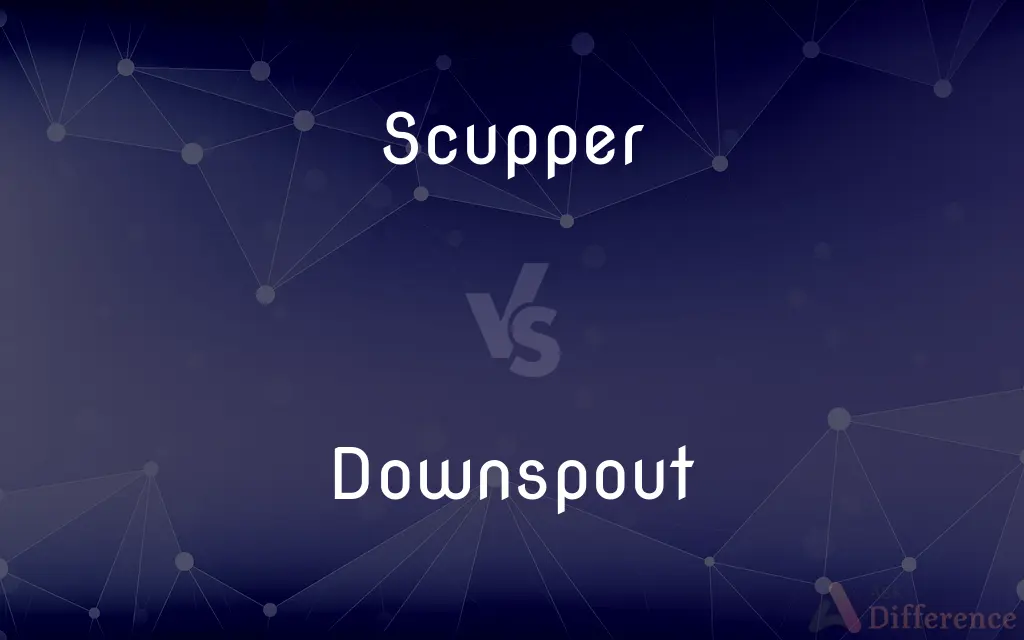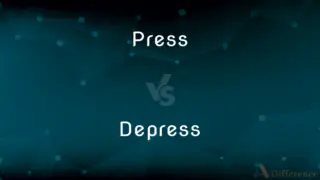Scupper vs. Downspout — What's the Difference?
Edited by Tayyaba Rehman — By Urooj Arif — Updated on April 23, 2024
Scupper channels water directly from roofs to prevent pooling, while downspouts direct water from gutters to ground level.

Difference Between Scupper and Downspout
Table of Contents
ADVERTISEMENT
Key Differences
Scuppers are openings in a wall or parapet that allow water to drain from flat roofs, avoiding water accumulation. In contrast, downspouts are vertical pipes connected to gutters that guide water from the roof to the ground, preventing water from seeping into the building’s foundation.
Scuppers typically do not require additional piping, making them an integral part of the roof’s drainage system. On the other hand, downspouts are part of a more extensive system that includes gutters, requiring installation along the building's exterior walls.
Often found in buildings without gutters, scuppers provide a direct pathway for water to exit the roof. Downspouts, however, are essential components of gutter systems and are necessary for effectively directing water away from the building’s base.
Scuppers are commonly used in commercial or industrial buildings and are particularly effective in regions with heavy rainfall. Conversely, downspouts are ubiquitous in residential and commercial properties and are vital in protecting the structural integrity of these buildings.
Due to their design, scuppers can be more visible and part of the architectural aesthetic, while downspouts are often designed to blend with the building's exterior or are hidden to maintain aesthetic appeal.
ADVERTISEMENT
Comparison Chart
Function
Drains water from flat roofs directly
Guides water from gutters to the ground
Installation
Part of the building's wall or parapet
Attached to the building’s exterior
Common Usage
Commercial buildings, areas with heavy rainfall
Residential and commercial properties
System Requirement
Does not require gutters
Requires gutters to function
Architectural Impact
Can be a visible part of the building’s aesthetic
Often designed to be inconspicuous
Compare with Definitions
Scupper
A drainage opening in a wall or parapet.
The scupper on the rooftop garden ensures no waterlogging.
Downspout
Integral to preventing water damage to foundations.
We added an extension to the downspout to protect the basement.
Scupper
An opening in a sidewalk's curb or along a street.
Scuppers along the street prevent flooding during heavy rains.
Downspout
A vertical pipe used to carry rainwater from a gutter.
The downspout needs to be cleared to prevent overflow.
Scupper
An escape route or overflow outlet.
The emergency scuppers were designed to divert floodwater.
Downspout
Usually made from materials like PVC or metal.
The metal downspouts are more durable but expensive.
Scupper
A device used to drain water off a ship's deck.
After the storm, the crew checked the scuppers for any blockages.
Downspout
Can be decorative and functional.
The copper downspouts add an elegant touch to the home’s exterior.
Scupper
A term used in naval language to denote a drain.
Clear the scupper to ensure smooth drainage.
Downspout
A component of household drainage systems.
Installing a larger downspout can improve water flow.
Scupper
A scupper is an opening in the side walls of a vessel or an open-air structure, which allows water to drain instead of pooling within the bulwark or gunwales of a vessel, or within the curbing or walls of a building. There are two main kinds of scuppers: Ships have scuppers at deck level, to allow for ocean or rainwater drain-off.
Downspout
A downspout, waterspout, downpipe, drain spout, drainpipe, roof drain pipe, or leader is a pipe for carrying rainwater from a rain gutter. The purpose of a downspout is to allow water from a gutter to reach the ground without dripping or splashing down the building structure.
Scupper
(Nautical) An opening in the side of a ship at deck level to allow water to run off.
Downspout
A downpipe.
Scupper
An opening for draining off water, as from a floor or the roof of a building.
Downspout
A vertical pipe for carrying rainwater down from a roof gutter.
Scupper
To sink (a ship) deliberately; scuttle.
Downspout
A vertical pipe or conduit that carries rainwater from the scupper, guttering of a building to a lower roof level, drain, ground or storm water runoff system.
Scupper
To thwart or ruin
Scupper a business deal.
Scupper
Chiefly British To overwhelm or massacre.
Scupper
(nautical) A drainage hole on the deck of a ship.
Scupper
(architecture) A similar opening in a wall or parapet that allows water to drain from a roof.
Scupper
(British) Thwart or destroy, especially something belonging or pertaining to another.
The bad media coverage scuppered his chances of being elected.
Scupper
An opening cut through the waterway and bulwarks of a ship, so that water falling on deck may flow overboard; - called also scupper hole.
Scupper
Drain that allows water on the deck of a vessel to flow overboard
Scupper
Wait in hiding to attack
Scupper
Put in a dangerous, disadvantageous, or difficult position
Common Curiosities
What is a scupper used for?
A scupper is used to drain water from flat roofs to prevent pooling and potential damage.
How does a downspout function?
A downspout functions by channeling water from roof gutters to the ground, safely away from the building’s foundation.
Are scuppers visible in building design?
Yes, scuppers can be quite visible and are sometimes incorporated into the architectural design of a building.
What materials are used to make downspouts?
Downspouts are typically made from materials like aluminum, copper, or PVC.
How do downspouts protect a building’s foundation?
Downspouts direct water away from the building’s foundation, preventing water damage and structural issues.
Do scuppers require regular maintenance?
Like all drainage systems, scuppers require regular maintenance to prevent blockages and ensure efficient water flow.
Where are scuppers most commonly installed?
Scuppers are most commonly installed in commercial buildings, particularly those with flat roofs.
Can downspouts be used without gutters?
Downspouts cannot function properly without gutters as they are designed to work together in a drainage system.
Can a scupper be installed in any building?
While scuppers are more common in certain types of buildings with specific architectural features, they can be adapted for various uses.
What happens if a downspout is blocked?
If a downspout is blocked, it can lead to gutter overflow, water damage to the building's exterior, and foundation problems.
Share Your Discovery

Previous Comparison
Press vs. Depress
Next Comparison
Progression vs. RegressionAuthor Spotlight
Written by
Urooj ArifUrooj is a skilled content writer at Ask Difference, known for her exceptional ability to simplify complex topics into engaging and informative content. With a passion for research and a flair for clear, concise writing, she consistently delivers articles that resonate with our diverse audience.
Edited by
Tayyaba RehmanTayyaba Rehman is a distinguished writer, currently serving as a primary contributor to askdifference.com. As a researcher in semantics and etymology, Tayyaba's passion for the complexity of languages and their distinctions has found a perfect home on the platform. Tayyaba delves into the intricacies of language, distinguishing between commonly confused words and phrases, thereby providing clarity for readers worldwide.
















































